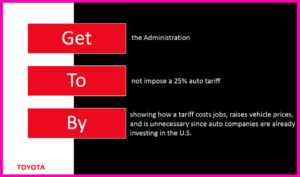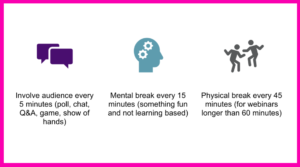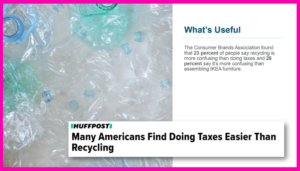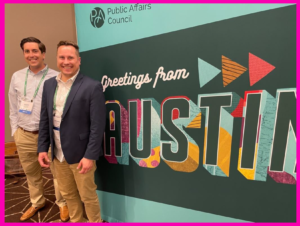Over the course of three days in Austin, we had the opportunity to network with professionals from across the country and hear firsthand from renowned government relations, communications, and public relations leaders on innovative best-practices and the latest trends in our industry. Session topics included advanced data strategies & tactics for advocacy campaigns, improving advocacy writing, crisis communications, training advocates, using social media as an advocacy tool, and so much more.
Here are my Top 3 Takeaways:
1. Define your goal. At its core, government relations is the art of motivating policymakers to make decisions that will benefit your client. And with CURA’s integrated approach that includes communications, public affairs, and advocacy—so it’s critical that we remain clear-eyed on our ultimate end goal.

The Get To By rule presented by Rebecca Steele, director of emerging technologies at Toyota, has helped CURA and our clients ensure alignment on our ultimate goals.
2. Make virtual events engaging. We’ve all been in a virtual meeting with seemingly no end in sight, watching your inbox fill up, and anxiously running through your mental checklist of to-dos. To have successful and effective meetings, you must keep your audience engaged. CURA leverages Zoom to provide advocacy training for our clients to help prepare them to effectively tell their stories and advocate to lawmakers.

Laura Brigandi, senior manager of advocacy & campaigns at the Pancreatic Cancer Network shared some great tips on how to keep your audiences engaged in online meetings that last more than 30 minutes. Including the audience every five minutes gives the speaker a break, while helping to ensure the audiences remains engaged. And certainly, giving mental and physical breaks will be appreciated by all!
3. Use data creatively. As effective government relations and communications professionals at CURA, we use data every day to help draw attention to our causes and reinforce our positions. But data doesn’t have to be overwhelming or boring. Audra Kruse, director of public affairs and digital engagement at AHIP shared 3 great tips and examples for telling a story through data.
What is memorable.
 Okay, who is going to forget that? Offering your audience a memorable stat or nugget draws them in and helps them remember you.
Okay, who is going to forget that? Offering your audience a memorable stat or nugget draws them in and helps them remember you.
What is impactful.
 Provide data and stats that reinforce your argument and help further your cause.
Provide data and stats that reinforce your argument and help further your cause.
What is useful.
 It’s not enough to talk about a problem, you must be able to share the data that shows the need for a solution.
It’s not enough to talk about a problem, you must be able to share the data that shows the need for a solution.

Of course, it wasn’t all business all the time. Austin prides itself on being the live music capital of the world, and the evening events hosted by conference sponsors did not disappoint! Scott and I had a great time reconnecting with colleagues and meeting new ones. We left Austin with lots of great tools and ideas—and importantly—came back reenergized to help our clients transform health care!
